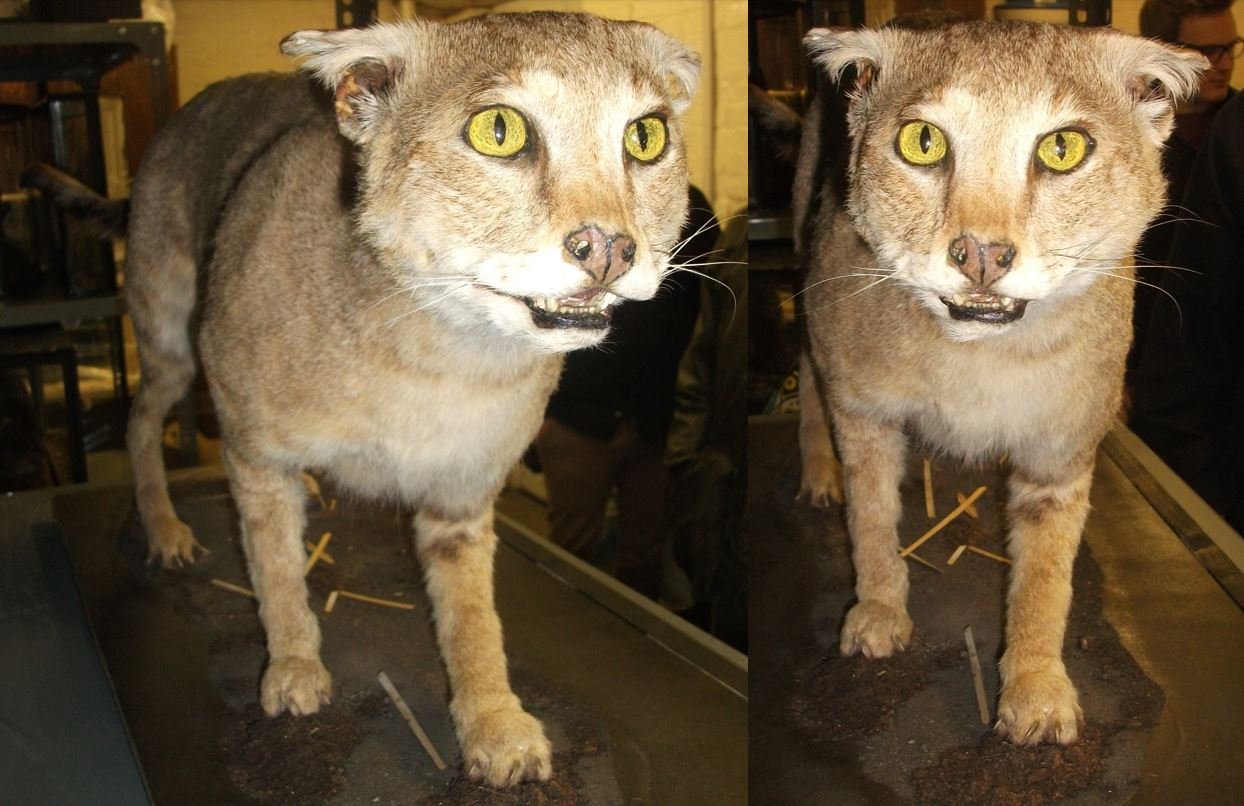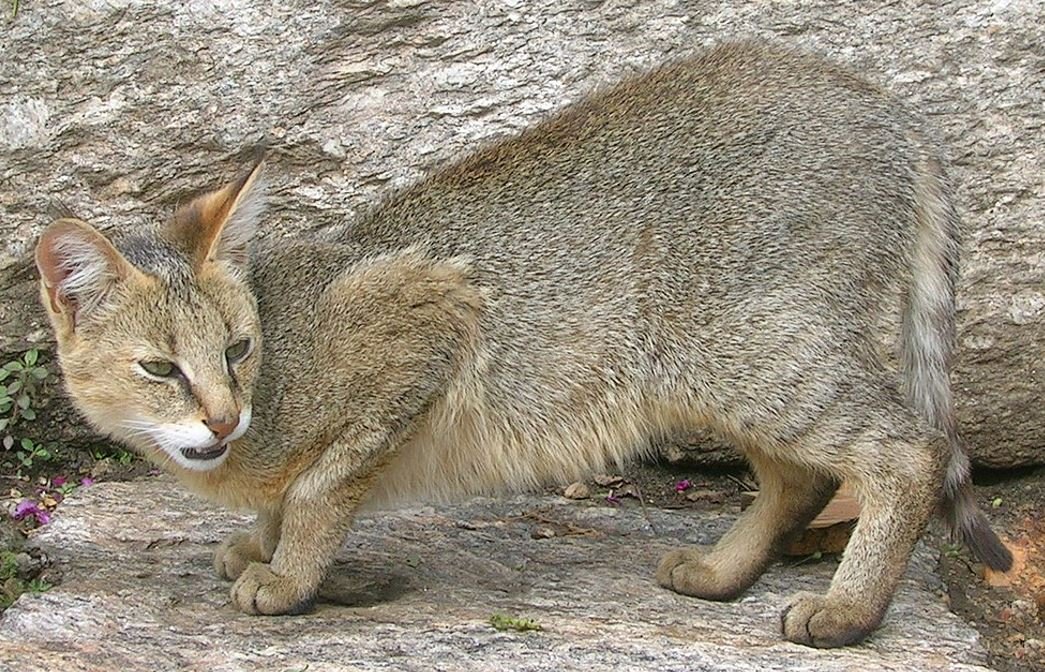Once again I’m giving you something from the archives, since there’s just no chance at all to produce anything new right now. Here, then, is a TetZoo ver 3 article that was originally published there in 2013 (that version is here). Ironically, that 2013 article was itself a republishing of a version from 2009…
Caption: Hayling Island Jungle cat in oblique anterolateral and anterior views. Note the prominent striping near the elbow, the indistinct striping elsewhere, and the short and slender tail. The individual’s colouring and short coat shows that it was from a pale, tropical population and not from one associated with more temperate places. Images: Darren Naish.
Over the weekend, I (with others) visited the Hampshire County Museum Service store at Chilcomb House, Winchester. Lots of fossils, preserved insects, and also taxiderm birds and mammals. I especially enjoy going there because it’s the repository of the famous Hayling Island Jungle cat (or Hayling Island Swamp cat). Here’s a photo of me and the cat. With permission (kindly provided by senior keep Christine Taylor), I’m taking several hair samples for ongoing work I’m involved in on the exotic cat fauna of the UK. Thanks to Phil Budd for the photo.
Caption: 2009 photo showing Darren Naish and Hayling Island Jungle cat. Photo by Phil Budd. I had to keep my coat on - the museum's storerooms are cold!
Some of you will know the story of the Hayling Island Jungle cat already: I wrote about it on Tet Zoo ver 2 (here) after seeing the specimen back in January 2009. Today, the cat is in pretty good shape and the taxiderm job that’s been done on it is of excellent quality. As Christine explained, however, this is actually ‘taxidermy take # 2’. ‘Take # 1’ wasn’t such a success, as you can see from this 1995 newspaper photo…
Caption: oh dear. The taxidermist tried their best, I’m sure.
As for the background to the cat’s history and origin, here’s a recycling of what I said about it in 2009… aaand again in 2013. The Jungle cat, Swamp cat or Reed cat Felis chaus is an Old World felid that occurs from Egypt in the west to southern China in the east. It’s not native to Europe, at least not nowadays. So, when one was run over and killed by a car on Hayling Island, Hampshire, in July 1988, people were surprised. Another dead one was found in 1989 near Ludlow, Shropshire. Back injuries and an underweight condition led to the suggestion that the Ludlow animal had starved after being injured by a car (Shuker 1995a, b). British cryptozoologist Karl Shuker now owns this specimen.
Caption: Dr Karl Shuker (at right, ha ha) with the mounted specimen of the Ludlow Jungle cat in its display case. The photo was originally taken in 1993 and is taken from the Shropshire Star.
What are Jungle cats doing at large in the UK? Based on sightings and photos, it seems that a number are feral here. A particularly good photo of one was taken in 1992 in Durham, and what seem to have been Jungle cats were seen on Hayling Island and in the Ludlow area prior to the discovery of the 1988 and 1989 corpses. Sightings continue on Hayling Island at least. It’s likely that at least some claimed ‘big cat’ sightings made in Britain are of Jungle cats, given that this animal is larger than a domestic cat and that – on seeing one – most laypeople would misidentify it as a puma or lynx. It has also been proposed that British Jungle cats may be hybridising with domestic cats, given the discovery in the Ludlow area of several animals that look like hybrids (Shuker 1993, 1995b). Jungle cats and domestic cats can and do hybridise, and their offspring – termed ‘chausies’ in the pet trade – are fertile.
Caption: Indian Jungle cat, photographed in Uttarakhand, India. Numerous F. chaus subspecies have been named but recent studies have reduced this down to three. The Indian animals belong to F. c. affinis. Image: L. Shyamal, CC BY-SA 3.0 (original here).
Presumably, the British Jungle cats are escapees from collections. The species was present in Britain during the Pleistocene (Schreve 2001a, b) but there’s no indication that it persisted into the Holocene. The behaviour of the species in Africa and Asia also indicates that it would be well able to survive in Britain. It adapts well to the presence of humans and can often be found in the vicinity of towns and villages (Nowak 1999). About 70% of its diet is made up of small mammals (mostly lagomorphs and rodents), and there are plenty of those in the British countryside (lagomorphs in particular of course).
And that’s it for now. For previous TetZoo articles on cats and other carnivorans, see…
The once mighty red panda empire, April 2008
The most inconvenient seal, June 2010
Hunter and Barrett's A Field Guide to the Carnivores of the World, March 2013
Conservation Concerns for South America's Remarkable Endemic Dogs, Revisited for 2022, January 2022
The Incredible South American Maned Wolf, March 2022
This blog benefits from your support. Thank you to those who help via patreon!
Refs – -
Nowak, R. M. 1999. Walker’s Mammals of the World, Sixth Edition . The Johns Hopkins University Press, Baltimore and London.
Schreve, D. C. 2001a. Mammalian evidence from Middle Pleistocene fluvial sequences for complex environmental change at the oxygen isotope substage level. Quaternary International79, 65-74.
Schreve, D. C. 2001b. Differentiation of the British late Middle Pleistocene interglacials: the evidence from mammalian biostratigraphy. Quaternary Science Reviews 20, 1693-1705.
Shuker, K. P. N. 1993. The lovecats. Fortean Times 68, 50-51.
Shuker, K. P. N. 1995a. British mystery cats – the bodies of evidence. Fortean Studies 2, 143-152.
Shuker, K. P. N. 1995b. The coming of supercat! Wild About Animals 1995 (1), 20-21.









